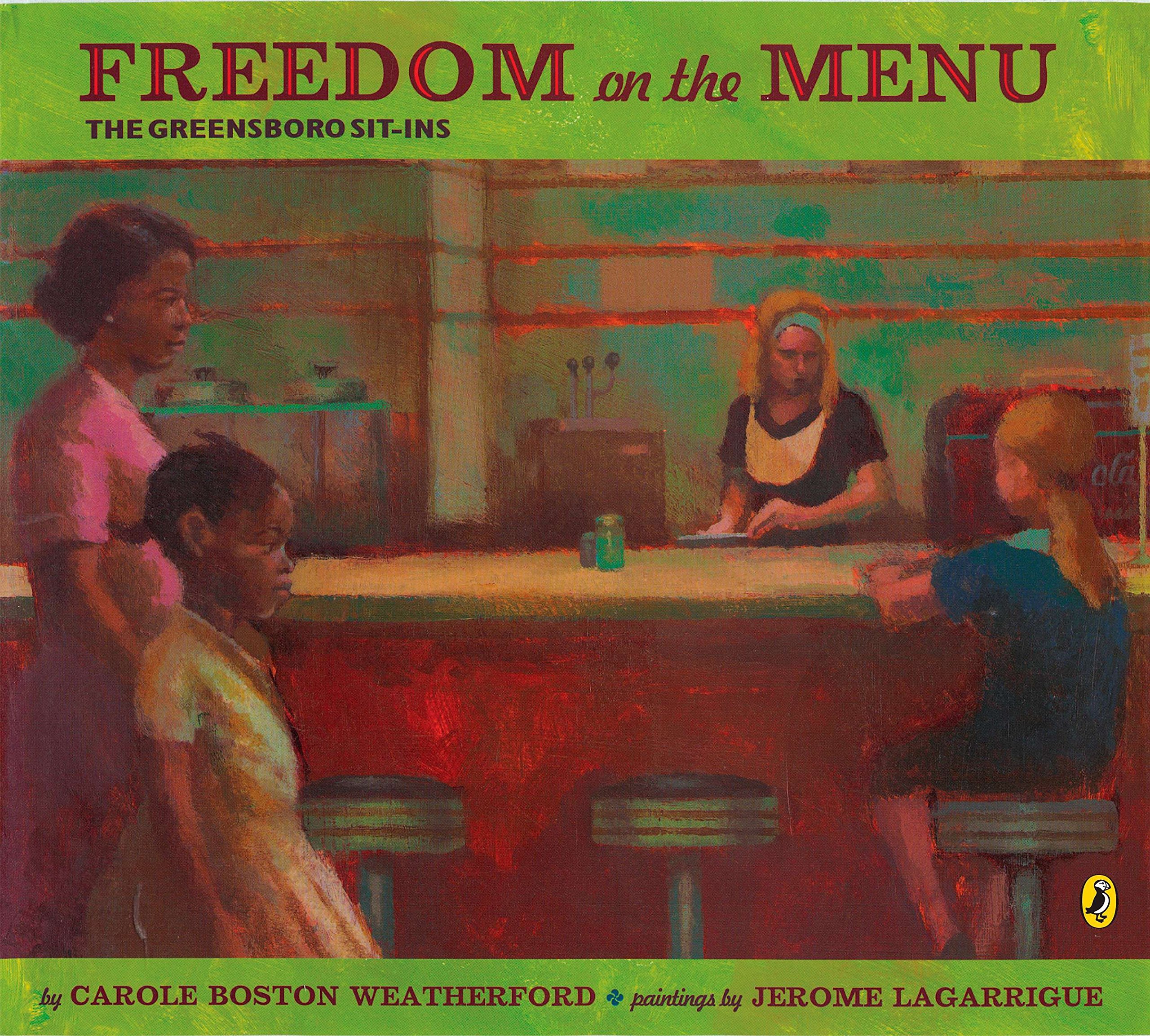Freedom on the Menu: The Greensboro Sit-Ins
Freedom on the Menu: The Greensboro Sit-Ins was written by Carole Boston Weatherford and illustrated by Jerome Lagarrigue Lagarrigue. This book was published by Puffin Books in December 27, 2007. It has 32 pages and appropriated for the readers from 4-8 years old. The item weight of this book is 4.8 ounces and the dimensions is 9.06 x 0.14 x 10.06 inches. Carole Boston Weatherford as the author of this book is now lives in High Point, North Carolina. [1] Retrieved January 31th, 2021
Summary
This book is a historical book that tells the story about a young black girl eight-year-old Connie where she could and could not go to some certain places. But when Connie sees four young men take a stand for equal rights at a Woolworth’s lunch counter in Greensboro, North Carolina, she realizes that things may soon change. This event sparks a movement throughout her town and region. And while Connie is too young to march or give a speech, she helps her brother and sister make signs for the cause. Changes are coming to Connie’s town, but Connie just wants to sit at the lunch counter and eat a banana split like everyone else. [2] Retrieved January 31th, 2021
Pros
A compilation feedback about this book can be seen on one online site, freedom on the Menu, by Carole Boston Weatherford, is a historical fiction children’s book that tells the story of the Greensboro Sit-Ins. The young narrator, Connie, provides the audience with her account of events surrounding the Civil Rights Movement and their impact on her life. Experiences related to segregation and the Civil Rights Movement are often told from adult perspectives and a child’s point of view adds refreshing diversity to the pool of literature surrounding the topic. By telling the story from a child’s point of view the author makes the book relatable to it’s young audience and reminds adult readers that children are influenced by events in the community. This book also addressing an important historical event, and the importance of believing and never giving up. The book helps readers understand that the Civil Rights Movement, and sit ins. I like that the moral of the story is that every one is equal no matter how they look. This book could be showcased during black history month, as a text to introduce the injustices that African Americans faced in our country, as well as a lesson on the importance of perseverance. [3] Retrieved January 31th, 2021
Freedom on the Menuis a well-told story that can be used in a variety of ways in your First Day School. It was probably written for third graders, but it will hold the interest of middle school students. You could create a one-day lesson around the story or use the book to open a whole unit on nonviolence or anti-racism.You could easily use Freedom on the Menuin a unit on one or more of the testimonies. [4] Retrieved January 31th, 2021
A personal reviewed was made by Deborah Hopkinson, she said that through Connie’s eyes, we see the role that young people played in breaking down these barriers, beginning when four college students sat at Woolworth’s lunch counter in Greensboro and asked to be served. Thanks to this and similar student-led sit-ins, on July 25, 1960, blacks were finally allowed to eat at the lunch counter. With its evocative art, child’s-eye perspective and an informative author’s note that includes a photo of the sit-in, Freedom on the Menu is an outstanding example of the kind of historical fiction that helps children better understand the past. [5] Retrieved January 31th, 2021
References
- ↑ https://www.amazon.com/Freedom-Menu-Carole-Boston-Weatherford/dp/0142408948
- ↑ https://www.amazon.com/Freedom-Menu-Carole-Boston-Weatherford/dp/0142408948
- ↑ https://www.goodreads.com/book/show/1004012.Freedom_on_the_Menu
- ↑ https://www.fgcquaker.org/sites/default/files/attachments/Review%20Freedom%20on%20the%20Menu.pdf
- ↑ https://bookpage.com/reviews/3966-carole-boston-weatherford-overcoming-barriers-childrens#.YBaQ7lgxVdg
